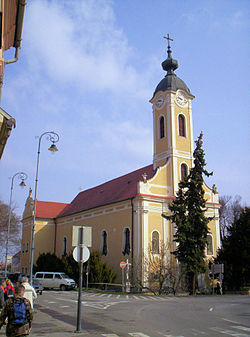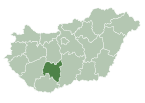Bonyhád
Bonyhád
Bonnhard (in German) | |
|---|---|
 Immaculate Conception Church | |
 Flag  Coat of arms | |
 Bonyhád Location of Bonyhád | |
| Coordinates: 46°18′02″N 18°31′51″E / 46.30056°N 18.53092°ECoordinates: 46°18′02″N 18°31′51″E / 46.30056°N 18.53092°E | |
| Country | |
| County | Tolna |
| District | Bonyhád |
| Area | |
| • Total | 72.14 km2 (27.85 sq mi) |
| Population (2004) | |
| • Total | 14,093 |
| • Density | 200/km2 (510/sq mi) |
| Time zone | UTC+1 (CET) |
| • Summer (DST) | UTC+2 (CEST) |
| Postal code | 7150 |
| Area code | (+36) 74 |
| Website | www |
Bonyhád is a town in Tolna County in Southwestern Hungary.
Government[]
It is governed by a city council and a mayor. The current mayor of Bonyhád is Filóné Ferencz Ibolya who has served in this capacity since 2014.
Populations[]
The town's ethnic composition includes Hungarians, Germans, Szekely and Romani. In the years leading to World War II, Bonyhád had a sizable Jewish population. In 1941, Jews constituted approximately 14% of the total population. The community was divided between Orthodox and Neolog Judaism traditions. At the time Rabbi Aaron Pressburger and Rabbi Lajos Schwartz were the town's Orthodox and Neologue rabbis. They accompanied their community to Auschwitz where they too were murdered.
After the occupation of Hungary by the German army in March 1944, the town’s remaining Jewish citizens were isolated and their property was confiscated by the Hungarian authorities. In May 1944, the Jewish population was estimated at around 1,300. Between May 12–15, 1944 the Jewish communities of Bonyhád, Bátaszék, Szekszárd and surrounding villages were moved to the two ghettos in Bonyhád. Some Jews were severely tortured to find out where they may have placed valuables. On July 1, 1944 those in the two ghettos were transported by train to the Lakitcs military barracks in the nearby city Pécs and from there deported in horrible conditions to Auschwitz, where most were murdered upon arrival on June 9, 1944 - Tamuz 18, 5704 on the Jewish calendar.[1][2][3][4] Bonyhád was captured on 30 November 1944 by Soviet troops of the 3rd Ukrainian Front in the course of the Budapest Offensive.
After the war a few survivors made an effort to reestablish in Bonyhád the two Jewish communities. After the 1956 revolt most of Bonyhád's Jews escaped from Hungary - mainly to North America and Israel. By 1963 there were only 4 Jewish families left in the town. Bonyhád's last Jewish resident, Mrs. Sári Warum, died in spring 2013.
Facilities[]
Bonyhád is home to the Völgység Museum. The town's population is served by a Roman Catholic church and a Lutheran church. The remains of the town's two Synagogues are still visible. There are nine cemeteries, including an Orthodox and the Neologue Jewish cemetery. Various sporting facilities and three high school/college compounds (e.g. Petőfi Sándor Evangélikus Gimnázium, Perczel Mór Szakközépiskola) along with the City Hospital currently serve the residents. Telephone service is provided by Bonicom Kft. Gas service is provided by Futomu Kft and water by Vizmu Reszleg.[5]
Sport[]
Twin towns – sister cities[]
 Borsec, Romania
Borsec, Romania Jastrowie, Poland
Jastrowie, Poland Pančevo, Serbia
Pančevo, Serbia Siculeni, Romania
Siculeni, Romania Treuchtlingen, Germany
Treuchtlingen, Germany Tvrdošovce, Slovakia
Tvrdošovce, Slovakia Wernau, Germany
Wernau, Germany
References[]
- ^ János Eisner: A Bonyhádi Zsidók Törtėnete (The story of Bonyhád's Jews) in Hungarian - Tel-Aviv, 1965
- ^ Leslie Blau: Bonyhád - A Destroyed Community - New York, 1994
- ^ Blau László: Bonyhád - Egy Elpusztított Zsidó Közösség (Bonyhád - A Destroyed Jewish Community) in Hungarian - Bonyhád, 2008
- ^ "Bonyhád". www.jewishvirtuallibrary.org.
- ^ "Bonyhád.hu". Bonyhád.hu.
- ^ "Partnertelepülések". bonyhad.hu (in Hungarian). Bonyhád. Retrieved 2021-04-09.
External links[]
| Wikimedia Commons has media related to Bonyhád. |
- Official website (in Hungarian)
- Street map (in Hungarian)
- Bonyhad Jewish Community
- Populated places in Tolna County


